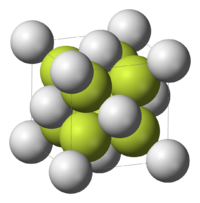
Photo from wikipedia
The solid electrolyte interface/interphase (SEI) is of great importance to the viable operation of lithium-ion batteries. In the present work, the interface between a tungsten oxide electrode and an electrolyte… Click to show full abstract
The solid electrolyte interface/interphase (SEI) is of great importance to the viable operation of lithium-ion batteries. In the present work, the interface between a tungsten oxide electrode and an electrolyte solution consisting of LiPF6 in a deuterated ethylene carbonate/diethyl carbonate solvent was characterized with in situ neutron reflectometry (NR) at a series of applied electrochemical potentials. NR data were fit to yield neutron scattering length density (SLD) depth profiles in the surface normal direction, from which composition depth profiles were inferred. The goals of this work were to characterize SEI formation on a model transition-metal oxide, an example of a conversion electrode, to characterize the lithiation of WO3, and to help interpret the results of an earlier study of tungsten electrodes without an intentionally grown surface oxide. The WO3 electrode was produced by thermal oxidation of a W thin film. Co-analysis of NR and X-ray reflectivity data indicated that the stoichiometry of the thermal oxide was WO3. As the electrode was polarized to progressively more reducing potentials, starting from open circuit and down to +0.25 V versus Li/Li+, the layer that was originally WO3 expanded and increased in lithium content. The reduced electrode consisted of two to three layers: an inner layer (the evolving conversion electrode) which may have been mixed W and Li2O and unreacted WO3 or LixWO3, a layer rich in protons and/or lithium, possibly corresponding to LiOH or LiH (the inner SEI), and an outermost layer adjacent to the solution with an SLD close to that of the solution, possibly consisting of lower SLD species with solution-filled porosity or deuteron-rich species derived from the solvents (the outer SEI), though the presence of this layer was tenuous. For the steps in the direction of more oxidizing potentials, the evolution of the layer structure was qualitatively the reverse of that seen when stepping toward more negative potentials, though with hysteresis. The SLD gradient suggested that the reaction was not limited by diffusion within the film. No clear phase boundary was evident in the evolving conversion electrode.
Journal Title: ACS applied materials & interfaces
Year Published: 2023
Link to full text (if available)
Share on Social Media: Sign Up to like & get
recommendations!